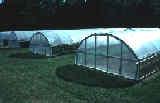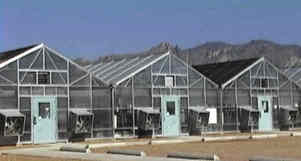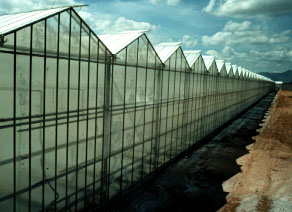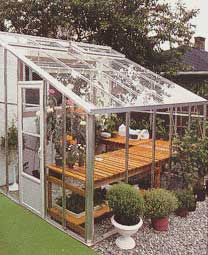- There are many choices in choosing a greenhouse
but the main factors you have to consider are:
- the amount of space you are going to need
- the amount of capital for investment
- training
- the type of business
- environmental requirements
- market
- labor requirements and
- personal preferences.
- good drainage
- accessibility
- available utilities and
- amount of sun exposure.
- minimal in size to permit maximum light into the greenhouse for the crops while still supporting itself
- heating and ventilating units and
- the weight of the crop which is trained to grow up a support system carried by the greenhouse frame.
- Glass is the most common cover: it reduces the shading of the crop from the support frame. Shading may seem minimal in greenhouses but it is estimated that 1% decrease in light would mean a 1% decrease in yield.
- 3 types of grades of glass include
- A Grade used for households
- B Grade used for store windows, greenhouses
- C Grade not so good
- Disadvantages of using glass include:
- inflexible
- heavy
- expensive and
- easily damaged by hail.
- Advantages include:
- permits high level light radiation into the greenhouse and
- durable.
-
 Polyethylene
sheet film: was developed in England in 1938. Since it was invented
it is used worldwide because it is easy to work with and inexpensive.
Polyethylene
sheet film: was developed in England in 1938. Since it was invented
it is used worldwide because it is easy to work with and inexpensive. - Different types of polyethylene film include.
- regular
- thickness is 4 mill to 6 mill
- cost is 100 dollars per sheet.or 2.5 cents per square feet.
- Disadvantages include high thermal emittance and UV degradation
- advantages include inexpensive, good for air insulate structure, keeps greenhouse humidity high and reduces heating costs by 35% to 40%.
- uv resistant polythylene
- thickness is 6 mill
- cost is 4 cent per square feet
- advantages include resistant to UV light, air inflated structures and greenhouse humidity
- disadvantages include priced higher than regular.
-
 Polyvinyl
chloride (PVC): mainly used in Japan in 1950's
Polyvinyl
chloride (PVC): mainly used in Japan in 1950's - thickness is 8 mill-12mill
- cost is 20 cents per square feet.
- advantages include soft and pliable
- disadvantages include electrical static collects dust, reduction of light transfer and the sheet turns yellow in 18-24 months
- There are many other coverings including:
- polyvinyl fluoride
- advantages include UV resistant
- disadvantage include brittle in winter and tearing at nail holes.
- rigid plastic pvc
- disadvantage is that it turns black
- plexiglass
- advantages include low thermal transmission, good light transmission and high weather resistant.
- disadvantages include scratches and expensive
- acrylic panels (Exolite)
- advantages include durability, reduction in heating costs and very pleasant appearance
- disadvantage is expensive
- lexan
- advantages include: resistant to hail damage, heat retention is good and light transmission.
-
 Quonset
Quonset - advantages include simple structure, fast to construct, can use plastic covering, air inflation can be used and clear obstruction
- Disadvantage is low side walls.
-
 this
is an example of a ridge and furrow green house.
this
is an example of a ridge and furrow green house. - Some advantages include costs less, less heating costs, more space utilization
- Disadvantages include high snow load, temp control is difficult
 Green
house covers:
Green
house covers:
Disadvantage is very expensive.
NDSU Horticulture professor Dr. Lee Notes from GreenHouse production management class
Growing
tomatoes hydroponically web site.
Green house
builders
 Greenhouses
Greenhouses